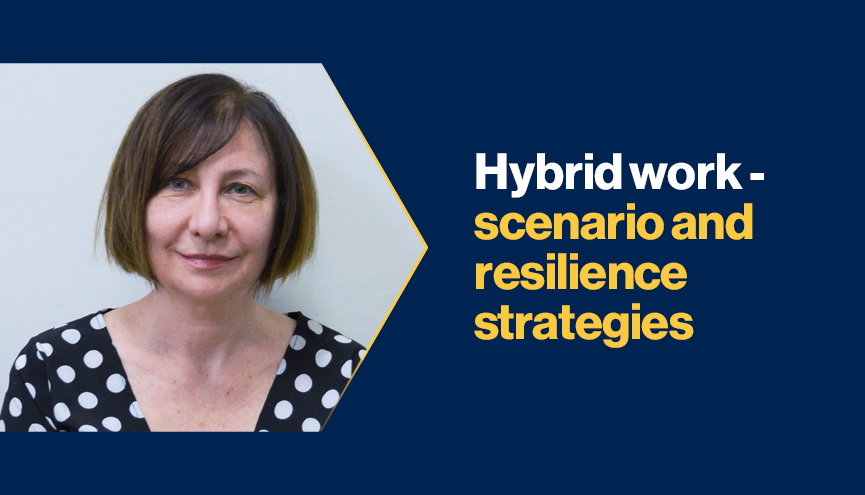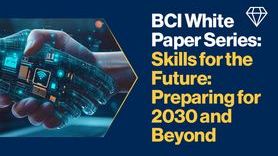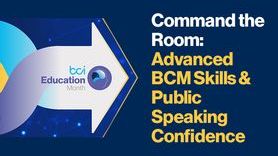Hybrid work – scenario and resilience strategies

Federica Maria Rita Livelli
Business Continuity & Risk Management Consultant
BCI ITALY CHAPTER Board Member
The significant shift to remote work during the pandemic has led to a rethink about the way we work. Many organizations are considering the permanent adoption of the hybrid work mode, both to meet employees’ growing demand for such a change (i.e. they are more likely to opt for a better work-life balance and to prioritize their health and wellbeing over work than before the pandemic) and also contain the costs deriving from the contingent economic and energy crisis. As a result, they will need to reorganize their strategies and address the challenges that hybrid work entails in order to ensure proper management of Business Continuity (BC), risk and cybersecurity.
Furthermore, over the last two years, hybrid work has accelerated the transfer of power from employer to employee, placing a new focus on employee motivations, digital skills, as well as trust in leadership behaviour and a more flexible work structure.
The Russel Leadership Monitor 2022 report reveals that 72% of surveyed leaders highlighted the low availability of talent and digital key skills as one of the threats to organizational resilience in the next 12-18 months. The threat has increased by 13% in the first half of 2022 compared to 2021. In addition, the uncertain economic growth, geopolitical crises, energy crisis, and ongoing conflicts all require organizations to be made up of resilient and adaptable people at all levels. Consequently, business objectives and strategies need to be carefully balanced and meet employees’ needs and expectations to ensure organizational and operational resilience.
Microsoft’s “Work Trend Index (WTI) 2022” report
It is interesting to note that, as per Microsoft’s survey of 31,102 people in 31 countries, results show:
- 52% of respondents are 'somewhat or extremely' likely to consider going remote or hybrid in the year ahead
- 51% of hybrid employees were considering a shift to remote working in the year ahead
- 57% of remote employees were considering a switch to hybrid
- 54% of managers feel that leadership is out of touch with employee expectations
- 74% of managers lack the influence or resources to make changes for their team
- 50% of leaders are planning a full-time return to the office (55% in sectors like manufacturing)
With respect to Gen Z, there’s now no going back, as flexibility, mobility and entrepreneurial freedom are non-negotiable. Actually, the report shows that:
- 58% of Gen Z are considering changing jobs in the year ahead vs. 43% overall
- 58% are considering a shift to hybrid work in the year head vs. 53% overall
- 56% are considering a shift to remote work in the year ahead vs. 49% overall
- 70% are considering earning additional income outside their current employer via a side project or business in the year ahead vs. 59% overall
Furthermore, the report reveals seven hybrid work trends that every organization should prepare themselves for:
- Flexible working cannot be abandoned
- Leaders risk losing touch with employees and need to be responsive on this front
- A high level of productivity hides an exhausted workforce
- Generation Z workers are struggling and in need of new energy
- Increasingly small working groups put innovation at risk
- Authenticity will spur productivity and well-being
- In a hybrid world of work, talent is everywhere.
The report also underlines how the adoption of hybrid work implies a change in strategy and suggests organizations adopt several strategies to support their evolution, including defining a plan to guarantee people maximum flexibility, investing in spaces and technologies to unite the physical and digital world, and also to counteract the feeling of "digital exhaustion" from above. Other strategies include prioritising social capital and corporate culture, as well as rethinking the worker experience to support the best talent and promote diversity.
Hybrid work vs. Business Continuity
The IT function and all the other security functions are becoming more and more fundamental in this new environment. They will have to work synergistically when updating and reviewing BC, disaster recovery and crisis management, and crisis communication plans. Those organizations adopting a hybrid work mode will have to guarantee:
- Adaptability – The organization must have the agility to deal with the fluid and variable nature of the new workplace and ensure a simplified approach.
- A more agile workforce – Hybrid work implies that organizations must be prepared for the unexpected and able to guarantee resilience regardless of their employees’ location. Therefore, they should be able to provide employees with all the necessary equipment, technology, and training to ensure employees react appropriately in emergency situations.
- Connectivity and availability/access to data, applications and cybersecurity – Employees should have a reliable internet connection and resilient IT infrastructure, regardless of their location, as well as having access to all the applications, data, and tools they need. In addition, cybersecurity must be integrated from the beginning and in all functions, processes, and activities. Furthermore, data privacy (in compliance with the EU GDPR and other privacy regulations at global level) should be always guaranteed. Cybersecurity policies and practices will likely have to be updated to protect against data breaches and ransomware attacks. There should also be strategies to resolve cyber-attacks and guarantee access to systems without delay.
- Intelligence – this activity contributes to BC in terms of adaptability, connectivity, collaboration and security through ad hoc automation and analytics-based decision-making.
In addition, other factors should be considered when reviewing the BC and disaster recovery function in a remote work mode:
- The unavailability of employees or key personnel through power/internet outages or equipment malfunctions should be considered when reviewing/updating BC and disaster recovery plans. Furthermore, adequate procedures (i.e. how to get employees back to work in the event of a crisis or outage) should be implemented.
- The need to implement a remote work policy
- The ability to understand how to access, manage and store data to mitigate any GDPR risk.
- The verification of BC plans for processes with a very low RTO (i.e., 1-4 hours) to properly estimate the response time when staff working remotely need to go back to the office and, if necessary, consider an alternative recovery strategy that requires less time.
- Monitor the mental health of employees in remote work by including training, online/offline social activities, and coaching and psychological support activity in the BC and crisis management plans.
- Managing communication by implementing a centralized communication/repository system should be considered as a solution for disaster recovery and crisis management, crisis communication/proper communication to interested parties, and to guarantee continuous updates to BC plans.
Diversity, Equity and Inclusion (DEI) in BC and remote work goals
Some organizations have set Diversity, Equity and Inclusion (DEI) objectives, but may have found difficulties in achieving them even before the pandemic. This is especially true if they did not continue to monitor benefits, ensure fair internal mobility, adapt workplace strategies to avoid discrimination, and guarantee employees are judged on their achievements, regardless of where they work.
A recent McKinsey survey - entitled "Hybrid work: making it fit your diversity, equity and inclusion strategy" - reveals that hybrid work can have a positive impact on DEI objectives, by guaranteeing a higher level of flexibility, a better work-life balance, and a more personalized employee experience.
It is time for an anthropocentric culture and to pay special attention to psychological security, with the support of HR and Leadership. The contingent scenario requires mindful leadership that leads with the “heart and mind.” Leadership is then able to guarantee a greater commitment and demonstrate a more authentic and open attitude.
Furthermore, inclusive strategies and active promotion of trust, collaboration, feelings of belonging, and cooperation among various teams should be considered when designing BC plans and, thus, ensure an inclusive and resilient hybrid work environment.
Italy – smart work and hybrid work trends
In Italy, over 6 million people worked from home during the acute phase of COVID-19 (March-April 2020), according to the Smart Working Observatory 2020 report issued by the Polytechnic University of Milan. Furthermore, remote/smart work is in use by:
- 97% of large companies
- 94% of organizations in public administration
- 58% of SMEs.
Although, a slight decrease in the number of remote/smart workers was recorded (from 5.37 million in the 1Q to 4.07 million in the 3Q) in 2021.
According to Randstad Research, out of 8 million potential Italian "smart workers", only a third are currently working remotely for at least one day a week. Also, if we consider the total number of employees, we can see that 13% of Italian workers work from home (5.9% for 2 or more days a week and 7.1% for less than 2 days a week).
When we compare the data of those who work from home for at least half the time against other European countries, we see that Italy is lagging behind and actually hindering remote work.
The Italian Association for Personnel Management (AIDP) has revealed in a recent report that 58% of 850 interviewed organizations are encountering problems in hiring or retaining employees if they do not guarantee remote/smart working options. In addition, 88% of companies confirmed that they would continue with remote/smart work even after the end of the state of emergency and adopt a hybrid work mode as follows:
- at least 2 days a week for 38% of organizations
- 1 day a week for 14% of organizations
- from 3-5 days of monthly presence down to a single day for smaller percentages.
The smart work revolution in Italy seems to have only permanently affected some professional categories - those that do not depend on a physical presence in the office and can easily work from home.
According to the Randstad Research, more women have chosen remote work than men (14% of women against 11.9% of men at the end of 2021). A further 6.6% of women worked from home most of the time (men 5.4%) and 7.8% of them less than 2 times a week (men 6.5%). The study also showed that approximately 60% of employees who worked from home were between 35-39 years old and only 20% were between 15-34 years old.
In Italy, as of September 1, employees can choose a hybrid work mode by signing an individual agreement, while workers who do not adhere to the agreement will have to work in the office.
The culture of resilience in Italy: where we are
It should be remembered that the culture of BC is not sufficiently widespread yet in Italy. Besides some big corporations, only a few SMEs have implemented the principles of BC, Risk Management and Cybersecurity in a structured way.
The lessons learned from the events of the last two years have undoubtedly led all organizations to reflect on the importance of incorporating these principles to ensure organizational and operational resilience. I am quite confident that the various associations representing these disciplines in Italy will contribute to spreading the culture of resilience in the country.
As BC, Risk Management and Cybersecurity professionals, it should be our duty to act as "magister", in the sense of the Latin term, to show organizations the way towards organizational and operational resilience – especially when adopting a hybrid work approach – to help them proactively react to this current erratic scenario.
Tempus fugit, so we can no longer wait. It is time to act resiliently.










































